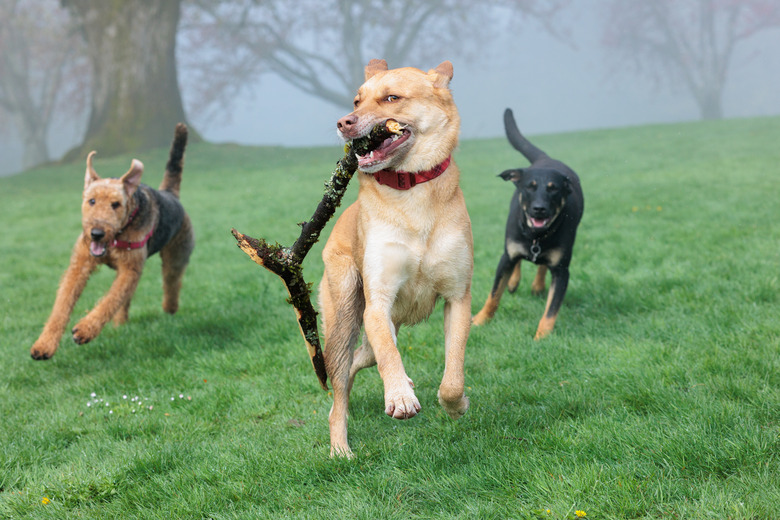How To Care For A Dog In Heat
Female dogs can go into heat as early as 7 months. While the average age is 9 months, most dogs generally experience their first heat between the ages of 7 and 11 months. It is ideal to have you dog spayed around 6 months of age, before this happens. Going into heat means that your dog is fertile and ready to mate, and mate she will if given the chance.
Getting your dog spayed before her first heat greatly reduces her risk of developing mammary cancer and reproductive tract infections. It also prevents unwanted pregnancies. If you choose to breed your dog or leave her intact for some reason, you'll need to learn how to care for a dog in heat.
How to care for a dog in heat
How to care for a dog in heat
Most dogs go into heat twice a year, with each heat cycle lasting around 21 days. During this time, your dog will bleed a bit, essentially having a period. Although most dogs bleed very little, your dog may produce just enough discharge that you won't want her on your furniture or carpet. One solution is to confine her to an area with linoleum floors or other easy to clean surfaces. If this means isolating her from the family, consider moving her crate to a socially significant part of the house and crating her instead. It's important that your dog not feel isolated or punished while in heat since this is a bodily function she can't control.
Another option is to purchase doggie diapers from the pet store. Although there is no such thing as dog tampons, you can get special menstrual diapers to catch your dog's discharge and keep it contained. Some dog owners even tuck a human maxi pad inside the dog diaper for extra protection and absorbency. Doggie diapers provide the added bonus of creating a physical barrier between your girl and any frisky males.
Provide constant supervision outdoors
Provide constant supervision outdoors
When your dog goes into heat, she may become clingy and vocalize often. She may also try to hump you, other pets, or her toys. Between these admittedly annoying behaviors and the period discharge, you may be tempted to leave her out in the yard. Don't do that. A dog in heat will bring the boys to the yard quickly, and they'll do anything to get to your pooch. Male dogs looking to mate will stop at nothing to get the job done, and many have found their way over, under, and even through backyard fences.
Even with supervision, avoid letting your dog roam free in places like the dog park. Though you'll be with her, the drive to mate is high in male dogs. They may become aggressive with you or their owners if you try to shoo them away from your dog. Always leash a dog in heat when taking her for walks as well. Though she may normally stay with you and listen well when off her leash, she could change her mind during a heat cycle and run off looking for a date.
Proper grooming makes life easier
Proper grooming makes life easier
To help keep life neat and tidy during the time of your dog's period, consider giving the fur around her genitals a trim. The discharge your dog expels during her heat cycle can get caught in this fur and create a messy and matted mess. This is particularly true of long-haired breeds. Carefully trimming back the fur around your dog's vulva may keep her more comfortable and make it easier to keep the area clean.
Watch out for pyometra
Watch out for pyometra
When your dog goes into heat, her body prevents infection-fighting white blood cells from entering her uterus. This ensures that sperm isn't attacked as a foreign body but is instead allowed to enter the womb and fertilize eggs. Your dog's cervix, normally closed, also opens to allow sperm entry. Unfortunately, bacteria can also enter your dog's body through her open cervix, and there won't be any white blood cells there to stop the invasion. This can lead to a dangerous and potentially deadly uterine infection known as pyometra.
Pyometra usually occurs two to eight weeks after a dog's heat cycle, but it can occur any time and may happen after treatment with medications containing progesterone. If the dog's cervix remains open, you may see pus coming from her genitals or stuck in the fur around them. If the cervix closes again, however, you won't see this symptom.
Other symptoms include fever, lethargy, depression, and a lack of appetite. Pyometra works quickly, so take your dog to the vet as soon as you can if you notice these issues. Prepare yourself for the possibility that your vet will recommend an emergency spay if your dog is suffering from pyometra. Saving your dog's life may depend on getting the spay done quickly, so you may not have time for a second opinion. A vet will always prioritize saving your dog over preserving her fertility.


